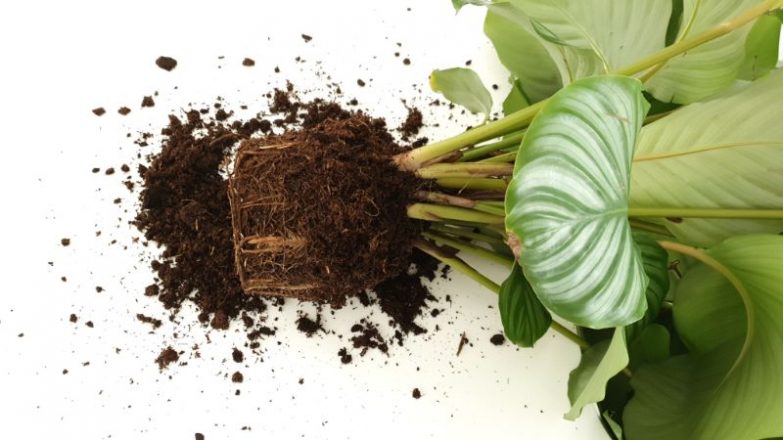Calatheas are sometimes considered to be as fussy to care for as they are beautiful. Whilst a bit of a challenge to keep looking their best, I can’t get enough of them, and my Calathea collection, or Goeppertia as they are now officially known, continues to grow. Thankfully, it’s quite simple to propagate Calathea plants, and this article is going to provide you with a step by step guide.
How to propagate Calathea plants: The easiest, most successful means of propagating a Calathea is to divide it when you repot the plant in spring. Carefully divide the roots at the natural divisions and pot each division separately. You can also grow Calathea plants from seed, although it can be more difficult to source Calathea seeds.
How To Propagate Calathea Plants
The best way to propagate a Calathea is by division at repotting time in the spring. When you remove the plant to repot it, you can gently divide the plant where it has created its own natural separations in the roots. Many calatheas have very fragile roots, so you should be as gentle as possible to prevent damage to the roots, that might negatively impact the growth of the divisions.
Plant them in new pots with fresh soil, then keep your new divisions warm, moist, and in as much humidity as possible. Provide reduced light until active growth starts again, within two to four weeks. Your Calathea should be repotted every few years into fresh potting mix and can be divided again each time.
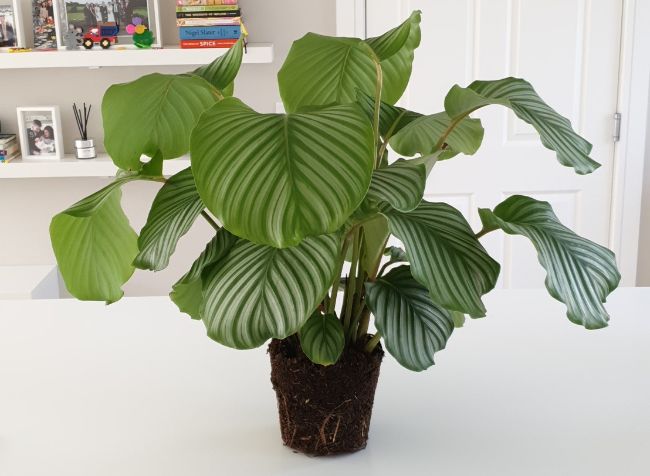
Why Propagate A Calathea Plant
There are many reasons to propagate your calathea plant.
If your Calathea has outgrown its pot, its a great time to divide your plant. Calatheas generally don’t like being repotted unnecessarily, so dividing your plant at the same time as repotting is a good idea to minimize disruption.
Dividing your Calathea gives you the opportunity to have more beautiful Calathea plants, or you could give the divided plants to friends or family, so they can enjoy them too.
Dividing your Calathea is also a good way of maintaining the size of your plant. If you like having your plant at a particular size, propagating by division prevents your plant from growing too large.
See my article on propagating houseplants for a complete guide to all the different propagation methods.
When To Propagate Calathea Plants
The best time to propagate a Calathea is in the early spring, when its new growth phase is just beginning. This is a natural time to repot and divide your plant and will help it recover from the stress of being divided more quickly.
How To Propagate A Calathea Plant
Follow these simple steps and you’ll be well on your way to successfully propagating your Calathea.
- Water your plant the day before you plan to divide it in order to reduce its stress and promote quicker recovery.
- Choose your new pots. Make sure the new pots have good drainage holes. The pots should be a couple of inches wider than the root ball of the divided portion of the plant.
- Place a paper towel or piece of coffee filter over the drainage holes to allow for good drainage without losing soil out of the bottom of the pot.
- Fill the pots about 1/3 of the way full with an appropriate potting mix. I use 2/3 peat moss and 1/3 perlite.
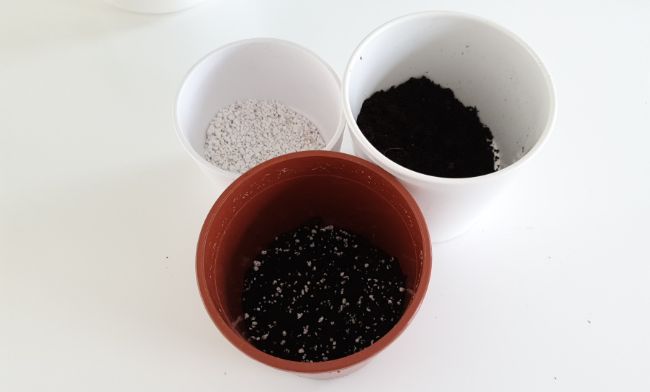
- Gently tip your Calathea on its side and slide it out of the pot.
- Brush away the loose soil and gently separate the roots a bit.
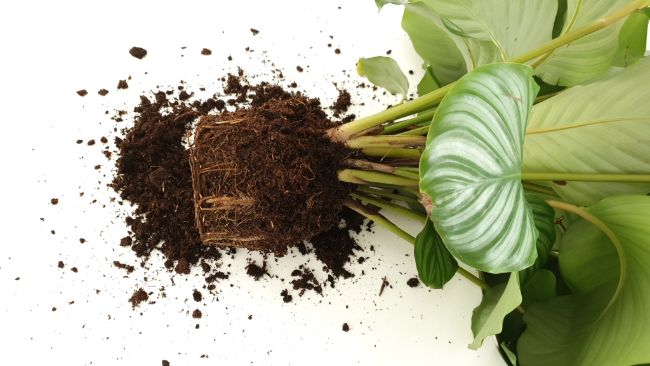
- Look for the natural divisions in the rootball and carefully separate the roots at these divisions. Gently work the roots free with your fingers. You should not need to break any roots as you divide the plant. Take your time.
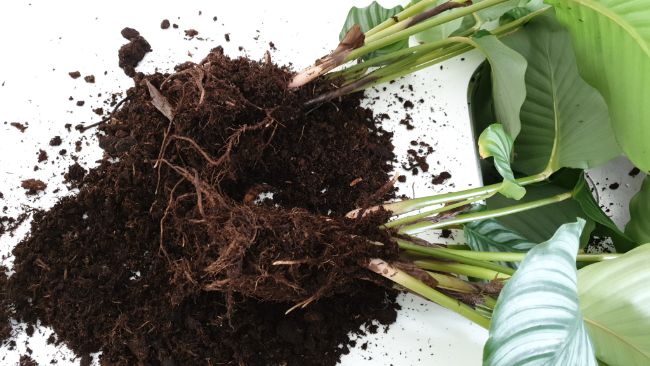
- Trim off any damaged or diseased roots. You’ll probably only need to divide the plant in two, unless it is a large plant. Then you may want to consider creating additional divisions.
- Place the roots of the offspring plants into the new pots and backfill the pot with soil up to the same soil level on the plant. You may want to use some of the soil from the mother plant to reduce stress on the offspring.
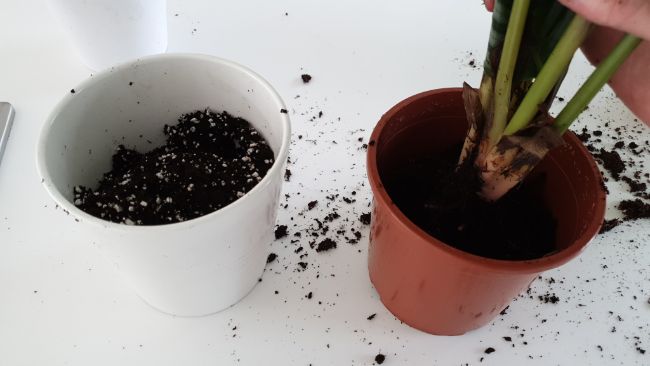
- Water your Calathea offspring and allow any excess water to drain away.
- You may want to cover your Calathea divisions with a clear plastic bag until you start to see new growth. This will mimic the conditions in a greenhouse and help hold in heat and humidity.
- Remove the bag once growth begins and continue to care for your Calathea offspring as you would your mother plant.
How Big Should The Plant Be?
Your Calathea will show you when it is big enough to be repotted. It will have natural divisions in the root ball. Don’t force a division or cut apart the roots before it is ready, just wait until the plant has grown large enough to create its own divisions. A healthy plant will probably be large enough to divide every spring.
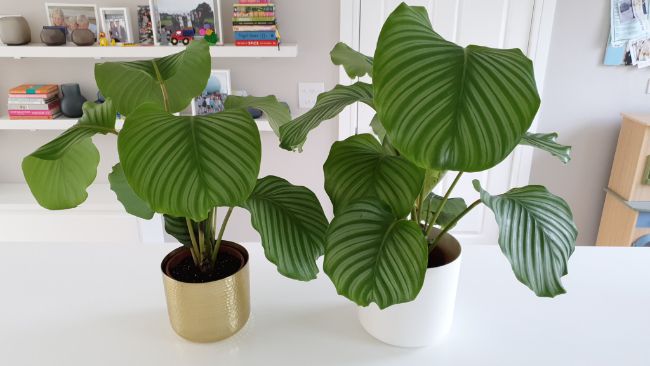
Are Any Calathea Varieties Easier To Propagate?
There are over three hundred varieties of Calathea and many of them are quite particular about the conditions they require. Thankfully, the process for propagating Calatheas is easy, but you need to be careful not to damage the plant or roots during the process.
Focusing on providing optimal care conditions after propagation is a key factor to successfully propagate calathea plants.
Calathea lancifolia (Rattlesnake Plant) and Calathea rufibarba (Velvet Calathea), are probably the easiest overall to care for and propagate. Calatheas with larger, thinner, more delicate leaves, such as Calathea orbifolia, Calathea warscewiczii, and Calathea makoyana are more difficult to successfully propagate and maintain flawless foliage.
Does Your Calathea Have To Be Healthy To Successfully Propagate?
You should always propagate healthy plants. Propagating a sickly plant might kill the mother plant or it may mean the divided plants won’t thrive. However, in some circumstances, propagating by division might be the only means to save a plant.
For example, a plant that has been damaged by receiving too much fertilizer might have a better chance to survive if it is divided and replanted into fresh soil.
Will Propagated Calathea Plants Be Identical To The Mother Plant?
Since the propagated plants are divisions of the mother plant, they should be identical. However, if you do not put the offspring plants into the same conditions as the mother plant, they may end up looking different than the mother. An example of this is when a variegated plant loses its variegation because it is no longer in the same lighting.
How Many Divisions Can Be Done From One Plant?
Generally, a calathea plant is divided in half at the time of repotting. However, if you have a larger plant you could create additional divisions, especially if the plant has naturally divided for you.
How To Care For Calatheas After Propagation
Calathea divisions need much of the same care as their parent plants. While they are deemed to be a bit ‘fussy’ in the world of tropical house plants, if you get the conditions right, you’ll have gorgeous offspring that are well worth the challenge.
For soil, you should choose a light, well-draining mix, with good moisture retention. I like to use a combination of two parts peat or coco coir and one part perlite. Most commercial houseplant potting mixes can be used, but I would strongly advise adding some perlite or an alternative drainage amendment to improve drainage.
Calathea plants, and especially offspring, need warm temperatures and indirect light. These tropical house plants need to stay above 65°F (18°C) and out of any drafts. They prefer bright indirect lighting and it is best to avoid direct sunlight as this can scorch the plant or cause fading of the beautiful color patterns.
Both your mother and offspring plants are sensitive to watering. You’ll only want to water when the top inch of the soil is dry. Then water thoroughly and let any excess water drain away (be sure to empty your drip tray, too). Calatheas can be sensitive to the chemicals in public water systems, so you may want to use rainwater, filtered water or distilled water if you are having problems keeping your calatheas in good health. See this article to learn more about the type of water to use for houseplants.
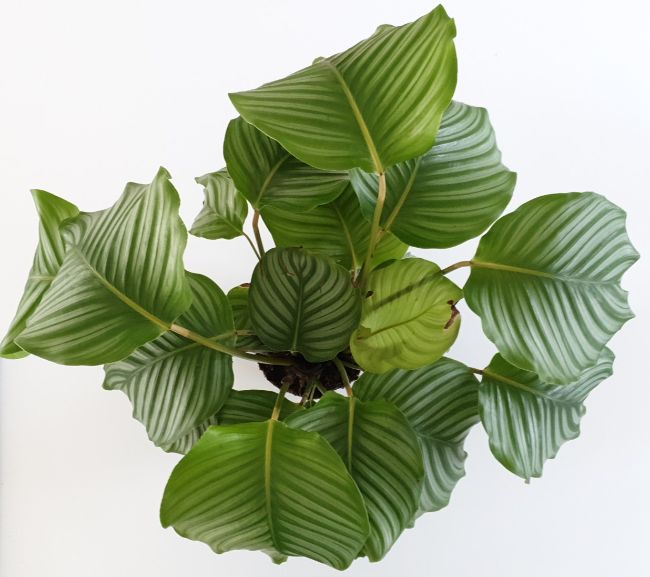
How Long Do The Divisions Take To Establish?
It may take two to four weeks for your Calathea divisions to settle into their new pots and begin to show new growth. They’ll use this time to adjust to the new conditions and recover from the shock of being separated and transplanted.
How Long For The Divisions To Grow To The Size Of The Original Plant?
Calathea are slower growing house plants, so it may take a while for them to reach the size of the mother plant. This is especially true if you divided up a large plant into multiple offspring. If you divided them in the springtime, they should be ready to divide again by the following spring.
Common Calathea Propagation Problems
If you have propagated your Calathea and the leaves are getting brown edges, this is probably an indicator that it has been given inconsistent moisture. Make sure to keep the soil evenly moist – like a wrung-out sponge – and keep the humidtiy around the plant high.
If the divided Calatheas start to close up when it isn’t evening time, they probably need a good drink of water. Water your Calatheas and see if the problem improves.
If the Calathea offspring fail to grow, it could be because they were not divided properly. When dividing your calathea, make sure that each division has a portion of roots and a portion of plant or the offspring will fail. Calatheas do not propagate succuessfully from leaf cuttings.
If your calathea offspring are wilting and drooping, it might be a sign that they are too cold or a caught in a draft. Move them to a warmer location.
If your baby Calatheas have brittle or brown tips on the leaves, or if your Calathea leaves are curling, it could be because there isn’t enough humidity. Place them on a pebble tray filled with water or group them closer together to increase the humidity around the plant. Read my guide to humidity for houseplants to learn more.
Because Calatheas are tropical plants, the mother plant as well as the offspring need high humidity, indirect light, well-draining soil, and consistent moisture. Although these plants are a little bit fussy and difficult to keep, their beautiful foliage makes caring for and propagating these plants a rewarding endeavor.
Can You Propagate Calathea Plants From Seed?
Although more difficult to do successfully, Calatheas can be propagated from seed. Your best option is to purchase seeds from a reliable supplier. Online stores are probably the best option, as your local plant nursery is very unlikely to stock Calathea seeds.
Here are the steps to maximize success with propagating Calatheas from seed:
- Seeds are can be grown in small pots or propagation trays. Use a seed-starting potting mix, or use a 1:1 combination of peat and coarse sand.
- Moisten the soil first to prepare the soil. Most Calathea seeds are best planted at a depth of 0.5-1cm deep.
- Cover the pots with plastic or use a propagation tray cover. This will help to maximize humidity and keep the seedlings warm.
- Consider using a heated seedling mat, as this will improve the germination success rate.
- Keep the soil lightly moist and place the pots in bright, indirect light.
- Once the seedlings are 3-4cm high, they can be very carefully transplanted into individual pots. Try not to disturb the delicate young roots when doing this.
Can You Propagate Calathea Plants From Cuttings?
Unfortunately, it is not possible to propagate Calathea plants from stem or leaf cuttings. Calathea stem cuttings simply do not contain the correct plant tissue to grow new roots and develop into a separate plant.
There are a number of plants that look similar to Calatheas, which can be propagated from stem cuttings, including Stromanthe and Ctenanthe species.

